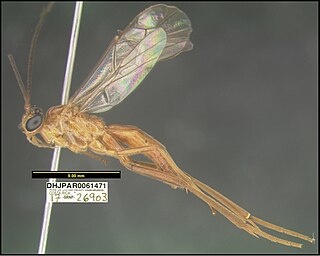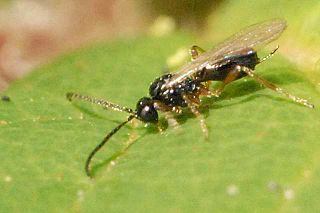
The Braconidae are a family of parasitoid wasps. After the closely related Ichneumonidae, braconids make up the second-largest family in the order Hymenoptera, with about 17,000 recognized species and many thousands more undescribed. One analysis estimated a total between 30,000 and 50,000, and another provided a narrower estimate between 42,000 and 43,000 species.

Trigonalidae is a family of parasitic wasps in the suborder Apocrita. They are the only living members of the superfamily Trigonaloidea. Trigonalidae are divided into 2 subfamilies; Orthogonalinae and Trigonalinae. These wasps are extremely rare, but surprisingly diverse, with over 90 species in 16 genera, and are known from all parts of the world. It is possibly the sister group to all Aculeata.

The Stephanidae, sometimes called crown wasps, are a family of parasitoid wasps. They are the only living members of the superfamily Stephanoidea. Stephanidae has at least 345 living species in 11 genera. The family is considered cosmopolitan in distribution, with the highest species concentrations in subtropical and moderate climate zones. Stephanidae also contain four extinct genera described from both compression fossils and inclusions in amber.

Microgastrinae is a subfamily of braconid wasps, encompassing almost 3,000 described species, with an estimated 30,000–50,000 total species. This makes it one of the richest subfamilies with the most species of parasitoid wasps.

Agathidinae is a subfamily of braconid parasitoid wasps. Some species have been used in biological control programs.

The Doryctinae or doryctine wasps are a large subfamily of parasitoid wasps within the family Braconidae.

The Bradynobaenidae are a family of wasps similar to the Mutillidae, differing most visibly in the presence, in females, of a suture separating the pronotum from the mesonotum. These species are often found in arid regions.

The Euphorinae are a large subfamily of Braconidae parasitoid wasps. Some species have been used for biological pest control. They are sister group to the Meteorinae.

The Pompilinae are a subfamily of the spider wasp family, Pompilidae, the species of which lay their eggs on the paralyzed bodies of their prey.
Distatrix is a genus of parasitoid wasps in the family Braconidae. There are more than 30 described species in Distatrix, found throughout most of the world.

Dinotrema is a genus of wasps in the family Braconidae. Species are amongst the largest parasitoid wasps in the tribe Alysiini (Alysiinae). There are approximately 350 species described around worldwide.
Shireplitis is a genus of braconid wasps native to New Zealand. Individuals range from 1.8 to 2.4 mm in body length. Five of the six known species occur on South Island, and one on the North Island. The genus name derives from the Shire, fictional home of the hobbits in the works of J. R. R. Tolkien, and five species are named after hobbits, with one species named after Tolkien himself.

The Thynnidae are a family of large, solitary wasps whose larvae are almost universally parasitoids of various beetle larvae, especially those in the superfamily Scarabaeoidea. Until recently, the constituents of this family were classified in the family Tiphiidae, but multiple studies have independently confirmed that thynnids are a separate lineage.

The Alysiinae are a subfamily of braconid parasitoid wasps with over 1000 described species. Several species have been used in biocontrol programs. They are closely related to the Opiinae.

The Cenocoeliinae are a subfamily of braconid parasitoid wasps.

The Homolobinae are a subfamily of braconid parasitoid wasps.
Dirrhope is the only extant genus in the subfamily Dirrhopinae of braconid parasitoid wasps. Dirrope was included in the Microgastrinae until 1984. Specimens of this genus have been found fossilsed in amber dating from the Cretaceous period.

Blacini is a tribe of braconid Parasitoid wasps.

Brachistinae is a subfamily of braconid wasps in the family Braconidae.
The Acampsohelconinae are a subfamily of braconid parasitoid wasps. Extant members of this subfamily were previously included in the Helconinae, Blacinae, or Sigalphinae. The four genera included are †Acampsohelcon, Afrocampsis, Canalicephalus, and Urosigalphus.
















